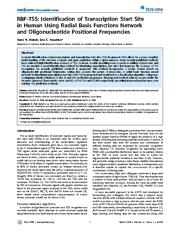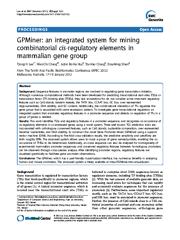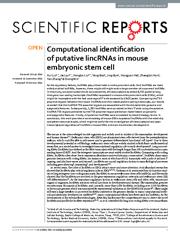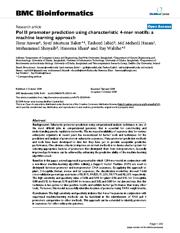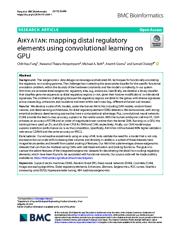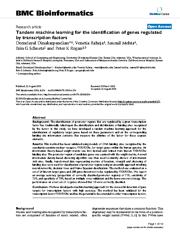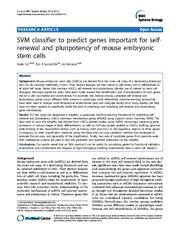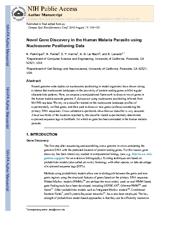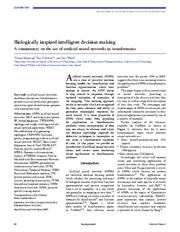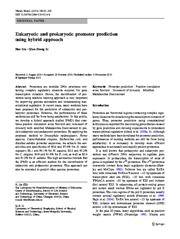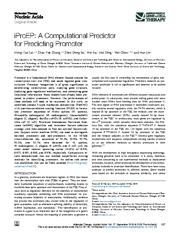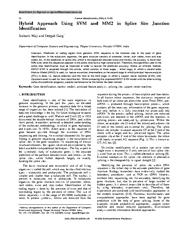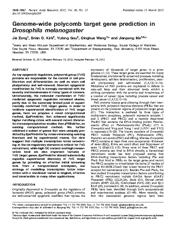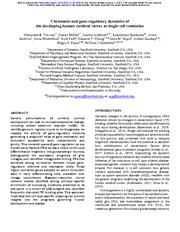A copy of this work was available on the public web and has been preserved in the Wayback Machine. The capture dates from 2019; you can also visit the original URL.
The file type is application/pdf.
Filters
RBF-TSS: Identification of Transcription Start Site in Human Using Radial Basis Functions Network and Oligonucleotide Positional Frequencies
2009
PLoS ONE
Accurate identification of promoter regions and transcription start sites (TSS) in genomic DNA allows for a more complete understanding of the structure of genes and gene regulation within a given genome ...
A radial basis function neural network for identifying transcription start sites (RBF-TSS) is proposed and employed as a classification algorithm. ...
The extracted positional frequency feature is used as an input into RBF-TSS, a classification algorithm for transcription start sites based on a radial basis function neural network (RBFNN). ...
doi:10.1371/journal.pone.0004878
pmid:19287502
pmcid:PMC2654504
fatcat:o3tiz3gee5hzlozm3zho2jkocu
GPMiner: an integrated system for mining combinatorial cis-regulatory elements in mammalian gene group
2012
BMC Genomics
Conclusions: The GPMiner, which has a user-friendly input/output interface, has numerous benefits in analyzing human and mouse promoters. The proposed system is freely available at ...
The proposed system allows users to input a group of gene names/symbols, enabling the cooccurrence of TFBSs to be determined. ...
The NNPP2.2 program applies a time-delay neural network for promoter annotation of the Drosophila melanogaster genome [14] . ...
doi:10.1186/1471-2164-13-s1-s3
pmid:22369687
pmcid:PMC3587379
fatcat:xi4guhr4hbbypn2sjpb2pjrkf4
Computational identification of putative lincRNAs in mouse embryonic stem cell
2016
Scientific Reports
Start Site) proximal regions based on the machine learning method RBF SVM. ...
Subsequently, 1,293 lincRNAs were corrected at their 5′ ends using the putative lincRNA TSS regions predicted by the TSS proximal region prediction model based on genomic and epigenetic features. ...
Next, the prediction model based on RBF SVM was constructed to identify the lincRNA TSS proximal regions on the genome-wide scale by the combination of genome features and the epigenetic modifications. ...
doi:10.1038/srep34892
pmid:27713513
pmcid:PMC5054606
fatcat:rsp77ten3zaw3jp52o7y6bpy7y
Pol II promoter prediction using characteristic 4-mer motifs: a machine learning approach
2008
BMC Bioinformatics
Eukaryotic promoter prediction using computational analysis techniques is one of the most difficult jobs in computational genomics that is essential for constructing and understanding genetic regulatory ...
Conclusion: The high sensitivity and specificity indicate that 4-mer frequencies in conjunction with supervised machine-learning methods can be beneficial in the identification of RNA pol II promoters ...
MS proposed the idea for the research and generated the project specification. HK reviewed the research manuscript and inspired overall analysis. ...
doi:10.1186/1471-2105-9-414
pmid:18834544
pmcid:PMC2575220
fatcat:orctrl2vs5hqllviuwqliy7v2e
AIKYATAN: mapping distal regulatory elements using convolutional learning on GPU
2019
BMC Bioinformatics
Plus, convolutional neural networks (CNN) provide the best-in-class accuracy, superior to the vanilla variant. ...
With the human embryonic cell line H1, CNN achieves an accuracy of 97.9% and an order of magnitude lower runtime than the kernel SVM. ...
We motivate the use of deep learning variants for our problem of predicting which genomic sequences represent DREs and show how to build an ML classifier based on a Convolutional Neural Network (RP-CNN ...
doi:10.1186/s12859-019-3049-1
pmid:31590652
pmcid:PMC6781298
fatcat:ymqqul65xjg4lc446yyfwvs3fi
Tandem machine learning for the identification of genes regulated by transcription factors
2005
BMC Bioinformatics
In this study, we have developed a tandem machine learning approach for the identification of regulatory target genes based on these parameters and on the corresponding binding site information contents ...
This method has been validated using models of DNA binding sites recognized by the xenobiotic-sensitive nuclear receptor, PXR/RXRalpha, for target genes within the human genome. ...
Acknowledgements We would like to acknowledge support for this project from the University of Missouri Research Board [UMRB Round 2, 2004] ...
doi:10.1186/1471-2105-6-204
pmid:16115317
pmcid:PMC1208855
fatcat:in5v5wamzjft3ozpjdl2ktthh4
SVM classifier to predict genes important for self-renewal and pluripotency of mouse embryonic stem cells
2010
BMC Systems Biology
Mouse embryonic stem cells (mESCs) are derived from the inner cell mass of a developing blastocyst and can be cultured indefinitely in-vitro. ...
Although significant steps have been made toward the identification and characterization of such genes, the list is still incomplete and controversial. ...
For ANN, we used the Neural Network Toolbox in MATLAB implementing back-propagation to learn a two-layered-feed-forward network with five neurons in the hidden layer. ...
doi:10.1186/1752-0509-4-173
pmid:21176149
pmcid:PMC3019180
fatcat:7dysnvjjbjfvzdzz7kygbcd7ky
SeqEnhDL: sequence-based classification of cell type-specific enhancers using deep learning models
[article]
2020
bioRxiv
pre-print
We propose SeqEnhDL, a deep learning framework for classifying cell type-specific enhancers based on sequence features. ...
DNA sequences of "strong enhancer" chromatin states in nine cell types from the ENCODE project were retrieved to build and test enhancer classifiers. ...
Introduction Cell type-specific enhancers, cis-regulatory elements that up-regulate gene transcription in a cell type, play a key role in determining the regulatory landscape of the human genome (1) . ...
doi:10.1101/2020.05.13.093997
fatcat:ujv5p3av2vglhmnmnxs4bvhxzq
Novel Gene Discovery in the Human Malaria Parasite using Nucleosome Positioning Data
2010
Computational systems bioinformatics. Computational Systems Bioinformatics Conference
Here, we propose a computational framework to discover novel genes in the human malaria parasite genome P. falciparum using nucleosome positioning inferred from MAINE-seq data. ...
Recent genome-wide studies on nucleosome positioning in model organisms have shown strong evidence that nucleosome landscapes in the proximity of protein-coding genes exhibit regular characteristic patterns ...
A Radial Basis Function (RBF) is an artificial neural network that uses radial basis functions as activation functions 13 . ...
pmid:25076982
pmcid:PMC4112967
fatcat:3fh7qljvevh3jokpqlsissrlpe
Biologically inspired intelligent decision making
2013
Bioengineered
A rtificial neural networks (ANNs) are a class of powerful machine learning models for classification and function approximation which have analogs in nature. ...
In this paper, we provide an introduction to artificial neural network theory and review some interesting recent applications to bioinformatics problems. ...
Acknowledgments This work was funded by the FP7-PEOPLE-2012-IAPP grant ClouDx-i to R.D.S. and P.W., and a Cork Institute of Technology Rísam Scholarship to M.T. ...
doi:10.4161/bioe.26997
pmid:24335433
pmcid:PMC4049912
fatcat:6yz3o5eijvbwrmagbibox6slci
Eukaryotic and prokaryotic promoter prediction using hybrid approach
2010
Theory in biosciences
Hence, the identification of promoters using machine learning approach is very important for improving genome annotation and understanding transcriptional regulation. ...
In recent years, many methods have been proposed for the prediction of eukaryotic and prokaryotic promoters. However, the performances of these methods are still far from being satisfactory. ...
This study was supported in part by the Fundamental Research Funds for the Central Universities (ZYGX2009J081) and the National Natural Science Foundation of China (61063016). ...
doi:10.1007/s12064-010-0114-8
pmid:21046474
fatcat:mkcjjxvi2negxehurg2lias5vq
iProEP: a computational predictor for predicting promoter
2019
Molecular Therapy: Nucleic Acids
Promoter is a fundamental DNA element located around the transcription start site (TSS) and could regulate gene transcription. ...
In the 10-fold cross-validation test, accuracies of 93.3%, 93.9%, 95.7%, 95.2%, and 93.1% were obtained for H. sapiens, D. melanogaster, C. elegans, B. subtilis, and E. coli, with the areas under receiver ...
C2017209244), and the Science Strength Promotion Programme of UESTC. ...
doi:10.1016/j.omtn.2019.05.028
pmid:31299595
pmcid:PMC6616480
fatcat:xvusvkgp3bfpnpu2ubzdtc5vta
Hybrid Approach Using SVM and MM2 in Splice Site Junction Identification
2014
Current Bioinformatics
Prediction of coding region from genomic DNA sequence is the foremost step in the quest of gene identification. ...
Therefore, the algorithms used in the splice sites identification must be improved in order to recover the prediction accuracy. ...
Ujjwal Maulik, Department of Computer Science & Engineering, Jadavpur University, Kolkata for their expert and valuable comments, and suggestions in preparing the manuscript perfectly. ...
doi:10.2174/1574893608999140109121721
fatcat:lc37zxp55je65bybzgwwsncsyu
Genome-wide polycomb target gene prediction in Drosophila melanogaster
2012
Nucleic Acids Research
In order to facilitate experimental identification of PcG target genes, here we propose a novel computational method, EpiPredictor, that achieved significantly higher matching ratios with several recent ...
Unfortunately, the molecular mechanism of PcGmediated epigenetic regulation remained elusive, partly due to the extremely limited pool of experimentally confirmed PcG target genes. ...
We also thank Kit Menlove for his input on the project. The source code of EpiPredictor is available upon request. Conflict of interest statement. None declared. ...
doi:10.1093/nar/gks209
pmid:22416065
pmcid:PMC3401425
fatcat:oomparoglfc5dpbftq577sqrle
Chromatin and gene-regulatory dynamics of the developing human cerebral cortex at single-cell resolution
[article]
2020
bioRxiv
pre-print
Basepair-resolution neural network models identified strong cell-type specific enrichment of noncoding mutations predicted to be disruptive in a cohort of ASD subjects and identified frequently disrupted ...
To identify genomic regions crucial to corticogenesis, we mapped the activity of gene-regulatory elements generating a single-cell atlas of gene expression and chromatin accessibility both independently ...
Coates and the VJ Coates Foundation (S.P.P.), the Human Frontiers Science RGY006S (W.J.G), the Stanford Brain Organogenesis Program in the Wu Tsai Neuroscience Institute and the Big Idea Grant (S.P.P.) ...
doi:10.1101/2020.12.29.424636
fatcat:3sf35eqhvrc45ihbukuau7qkwm
« Previous
Showing results 1 — 15 out of 47 results

